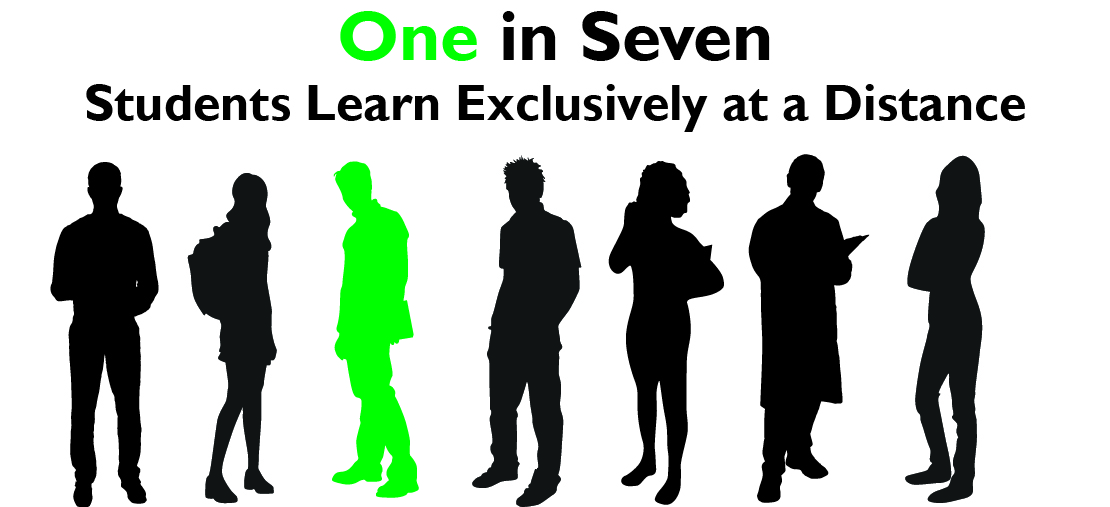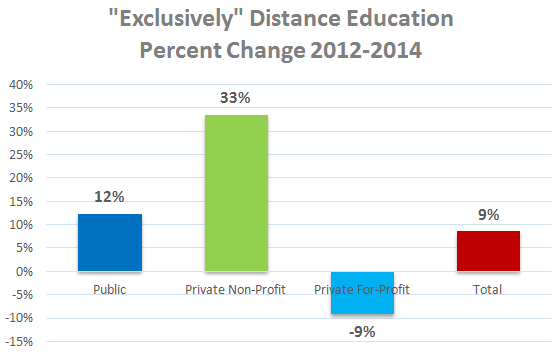New WCET Distance Ed Enrollment Report Shows Continued Growth
Published by: WCET | 2/8/2016
Tags: Data And Analytics, Distance Education, Enrollment, Forprofit Universities, IPEDS, Research, Survey, U.S. Department Of Education, WCET
Published by: WCET | 2/8/2016
Tags: Data And Analytics, Distance Education, Enrollment, Forprofit Universities, IPEDS, Research, Survey, U.S. Department Of Education, WCET
We are pleased to announce the first issue of a new report, the “WCET Distance Education Enrollment Report 2016: Using IPEDS 2014 Fall Enrollment Data.”
Based on data accumulated by the U.S. Department of Education’s Integrated Postsecondary Education Data System’s (IPEDS) 2014 Fall Enrollment survey, we decided to create a single report instead of a series of blog posts. The report highlights differences in distance education enrollments by sector, graduate vs. undergraduate study, student location, and by the number of institutions educating students at a distance. Our aim is to enlighten readers about the current state of the industry through graphs, data tables, observations, and commentary based on our insights.
Our Partnership with Babson Survey Research Group
We are also pleased that we partnered with the Babson Survey Research Group (BSRG) this year. Today they released the latest in their series of reports of online learning: “Online Report Card: Tracking Online Education in the United States.” Through our partnership:
BSRG has announced that, in the future, it will wind down its annual online education report. In the future, WCET plans to continue providing insights into IPEDS distance education enrollments. We also will focus on different aspects of the data from year-to-year.
 Highlights of Enrollment Analyses
Highlights of Enrollment Analyses
Overall distance education enrollments are continuing to grow from year to year, even as overall higher education enrollments decline. But, you have to look more closely at the details to get a more complete picture for the Fall of 2014. Note especially the difference by higher education sector.
In our report, we again highlight some of the problems with the data collected by IPEDS. Even so, this is the best and most comprehensive data that is currently available.
Distance Education is a Key Component of Higher Education in the United States
One in seven (14%) of all higher education students took all of their courses “Exclusively” at a distance. More than one-in-four students (28%) enrolled in “At Least One” distance education course.
Distance Education Grows while Overall Enrollment Dips
Overall higher education enrollment declined by 2% from 2012 to 2014. Meanwhile, the number of students enrolled “Exclusively” at a distance grew by 9%.
Growth Differs Greatly by Sector
Enrollments for those learning “Exclusively at a distance grew by 12% for the public sector and a remarkable 33% for non-profit institutions. Meanwhile, the number of for-profit students declined by 9% over this same time period.
Of special note is that the for-profit sector almost fell to being the sector with the fewest distance enrollments “Exclusively at a distance. This is a remarkable outcome considering the for-profit sector led the private, non-profit sector by more than one-quarter million (297,521) enrollments in 2012. In 2014, that difference fell to only 422 enrollments.
Identifying the Location of Distance Students Continues to Be a Problem
The survey asks for the location of the student, which is interesting both from analyzing geographic reach of institutions, but also compliance with state authorization regulations. The WCET State Authorization Network helped to support this report.
There was a large increase (66%) in the “Student Location Unknown/Not Reported” category and a decrease (14%) in students reported in the “In U.S., State Unknown” category. The increase may be mostly due to a few large institutions that changed their reporting.
Acknowledgements
Many thanks to Terri Taylor Straut. This is the third year that she has contracted with WCET to perform the dirty work of making her way through the intricacies of the data sets and has helped in providing useful insights.
We also appreciate partnering with Jeff Seaman of the Babson Survey Research Group. Working together we were able to identify new dataset parameters that improved on each of our practices in previous years. Additionally, by dividing the work, we were both able to provide more results for our users than we were able to do working separately.
We hope you enjoy the new report and we look forward to obtaining your feedback.
Note: We reported some preliminary results in December. Any differences should be due to the changes that we made in harmonizing our data set with that used by BSRG. We suggest using the updated data and analyses in this report.
Russ
Russ Poulin
Director, Policy and Analysis
WCET
If you like what we do, join WCET.
1 reply on “New WCET Distance Ed Enrollment Report Shows Continued Growth”
[…] WCET’s comparison of Fall 2014 to past years […]